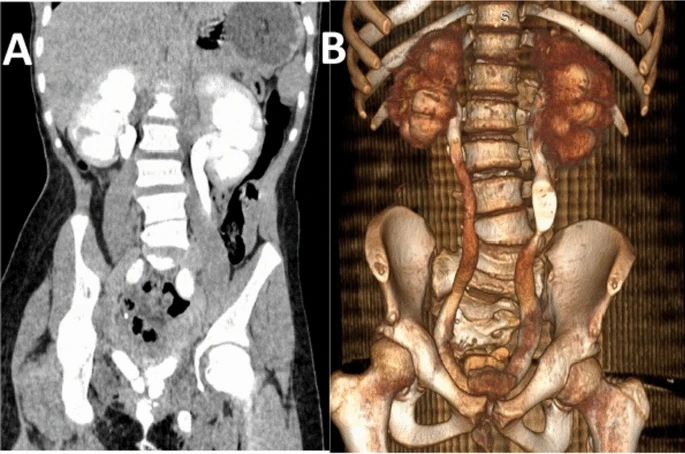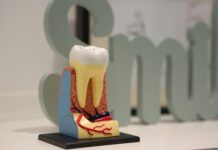Case Report
Bilateral single-system ectopic ureters are one of the most unusual urological disorders, with fewer than 80 examples documented in the literature. Urinary incontinence and recurrent urinary tract infections are the most frequently reported primary symptoms. The most critical difficulty in these situations is to preserve bladder size and functional growth as a result of the surgical operation while protecting renal function.
This is the story of a 14-year-old female adolescent who was identified with bilateral ectopic ureters and underwent bilateral ureteric reimplantation, resulting in acceptable continence without the need for significant reconstruction surgery.
Case Presentation
A 14-year-old Ethiopian female teenager appeared with constant dribbling of urine and no voiding stream from birth. She has a history of recurring urinary tract infections. At the age of one year, the patient underwent surgical correction for an anorectal malformation with a rectovestibular fistula at another institution, but was unable to continue follow-up care due to financial constraints. She had occasional soiling as a result of this and no other issues. She has no family history of comparable illnesses.
Investigation
The physical examination was ordinary, with normal external genitalia and no neurological problems. All regular procedures, including hemoglobin, total leukocyte count, renal function tests, and urine microscopic examination, were within normal limits. Abdominal sonography demonstrated both moderate hydronephrosis and hydroureters.
Computed tomography (CT) urography revealed a low-capacity bladder with bilateral ectopic ureteral apertures and a mild bilateral hydroureter. Coronal and three-dimensional reconstruction images used to determine the anatomical orientation of the kidneys, ureters, and bladder. The voiding cystourethrogram revealed a bladder capacity of 150 ml and a grade 4 vesicoureteral reflux in the left ureter.
The urethral and vaginal apertures were normal during the anesthetic examination, however the patient was constantly leaking urine from the urethral hole. No further odd holes were discovered. Cystoscopic examination revealed a large urethra, with both ureteric orifices positioned within the urethra and an unclear trigone.
A diagnostic cystoscopy verified the diagnosis, and surgical intervention in the form of bilateral ureteric reimplantation was scheduled. The pelvic organs were examined using a Pfannenstiel incision, and the bladder and both ureters were identified. Bilateral Politano-Leadbetter ureteric reimplantation was then carried out. During the early postoperative phase, the patient maintained daytime continence but had to urinate often. Nocturnal incontinence was observed.
Over the first six months, the patient was followed on a monthly basis, and her continence and urinary voiding patterns improved gradually. The follow-up plan has since changed to every three months. During the most recent evaluation, the patient reported having 2-3 monthly episodes of nocturnal incontinence. Renal function tests were normal, and the abdominal ultrasound results were unremarkable. Cystourethrography was not practicable because of financial constraints.
Discussion
Ectopic ureter is a condition in which the ureter does not connect to the trigone portion of the urine bladder. Ectopic ureters occur in around one in every 2000-4000 individuals. The female-to-male ratio for this disorder ranges between 2 and 6:1, with females having a higher prevalence. Ectopic ureters are frequently seen in association with a duplicated urinary tract system, which occurs in around 80% of cases. In contrast, single-system ectopic ureters are less common, accounting for 10-20% of cases. Bilateral single-system ectopic ureters are extremely uncommon in all circumstances.
Female patients with bilateral single-system ectopic ureters have poor trigone and bladder neck muscle development. This is due to the ectopic ureteral apertures being positioned outside the bladder, which is unable to distend with urine. Furthermore, a poorly established bladder neck and a malfunctioning urethral control system impede bladder expansion. The most prevalent symptoms include urinary tract infection (UTI), incontinence, and renal failure. Similarly, our patient reported urinary incontinence and a history of recurring urinary tract infections. She also had a history of intermittent fecal soiling linked with a past anoplasty treatment for an anorectal deformity with a rectovestibular fistula.
Surgery is the most effective treatment for this illness since it reduces incontinence, maintains renal function, and prevents recurring UTIs. The unused urinary bladder due to bilateral single system ectopic ureters has a little capacity and is nonfunctional. Ureteric reimplantation is difficult in a small capacity bladder, and the functional outcome is poor due to underdeveloped muscles and innervation.




